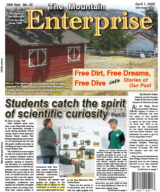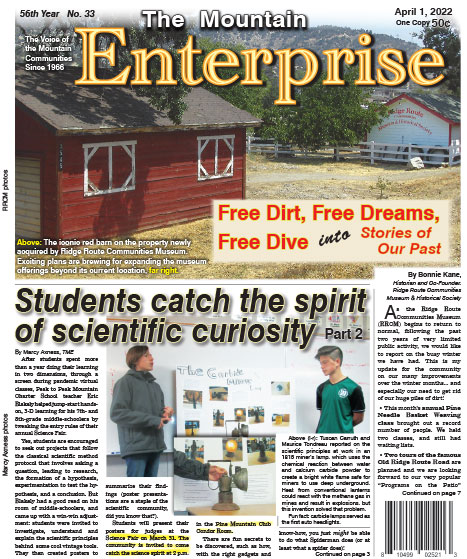By Marcy Axness, TME
After students spent more than a year doing their learning in two dimensions, through a screen during pandemic virtual classes, Peak to Peak Mountain Charter School teacher Eric Blakely helped jump-start hands-on, 3-D learning for his 7th- and 8th-grade middle-schoolers by tweaking the entry rules of their annual Science Fair.
Yes, students are encouraged to seek out projects that follow the classical scientific method protocol that involves asking a question, leading to research, the formation of a hypothesis, experimentation to test the hypothesis, and a conclusion. But Blakely had a good read on his room of middle-schoolers, and came up with a win-win adjustment: students were invited to investigate, understand and explain the scientific principles behind some cool vintage tools. They then created posters to summarize their findings (poster presentations are a staple of the scientific community, did you know that?).
Students will present their posters for judges at the Science Fair on March 31. The community is invited to come catch the science spirit at 2 p.m. in the Pine Mountain Club Condor Room.
There are fun secrets to be discovered, such as…(please see below to view full stories and photographs)
Photo captions:
Tuscan Carruth and Maurice Tondreau reported on the scientific principles at work in an 1815 miner’s lamp, which uses the chemical reaction between water and calcium carbide powder to create a bright white flame safe for miners to use deep underground. Heat from conventional lanterns could react with the methane gas in mines and result in explosions, but this invention solved that problem.
Fun fact: carbide lamps served as the first auto headlights.
Danica Crowder and her science partner used the scientific method beginning with the question above. Their background research led them to a hypothesis that they then tested and did troubleshooting on to get their results.
Nico Tomaselli explained the physics at work in a pressure cooker (including adjustments needed at 5,000’ altitude).
Kaydence Day explained how a vintage espresso maker works (which had always been a mystery to this reporter!).
Riley Franco’s chemical lava lamp.
Jane Clark and Biankah Arellano studied the kerosene lamp.
Dallas Nevins and Ely Barahona researched the physics of a wood-burning cook stove.
To see full stories with photos, please purchase a copy of the newspaper at many locations (click this link for a list) throughout the Mountain Communities.
Or, have your newspaper delivered via mail and include internet access. Just call 661-245-3794. Classified ads are FREE to paid subscribers! See front page at www.mountainenterprise.com for details.
The e-Edition is available now with full photos and stories at The Mountain Enterprise e-Edition. Select the 2022-0401 edition.
(subscriber login required)
This is part of the April 1, 2022 online edition of The Mountain Enterprise.
Have an opinion on this matter? We'd like to hear from you.

![[Marcy Axness photo]](https://mountainenterprise.com/wp-content/uploads/IMG_5030cu.jpg)

